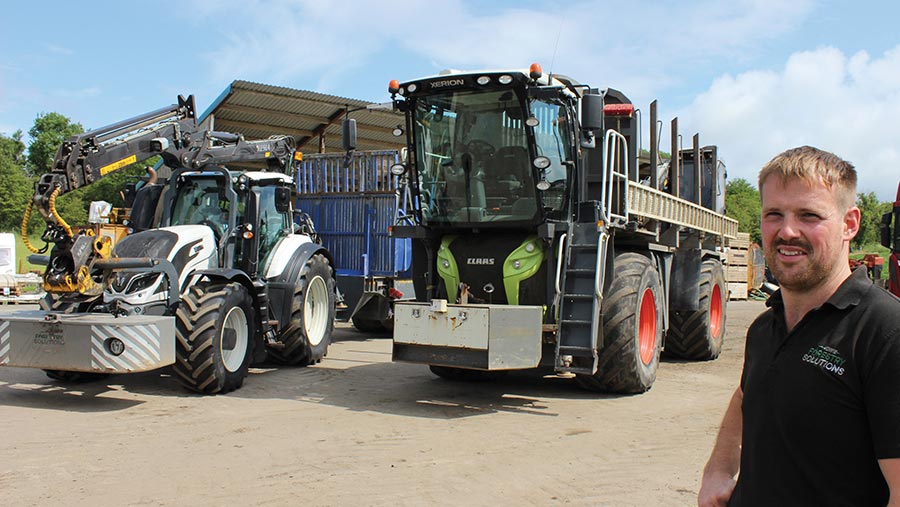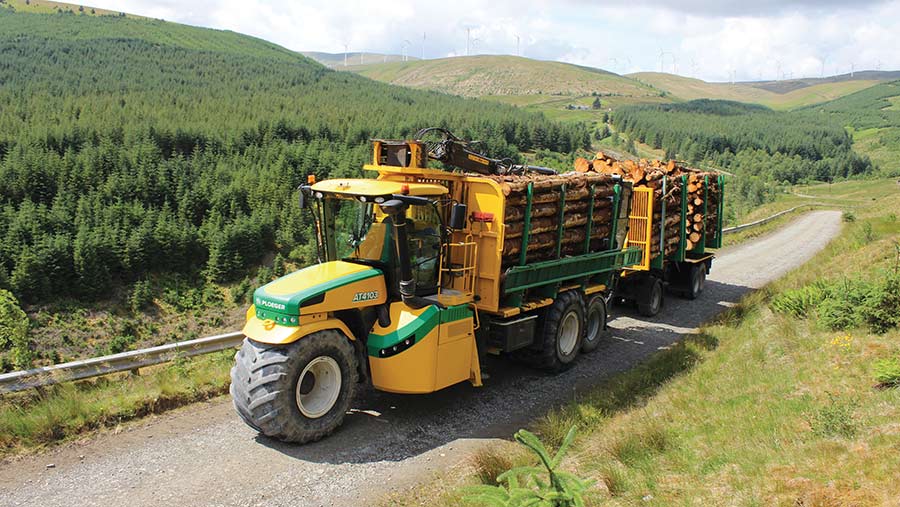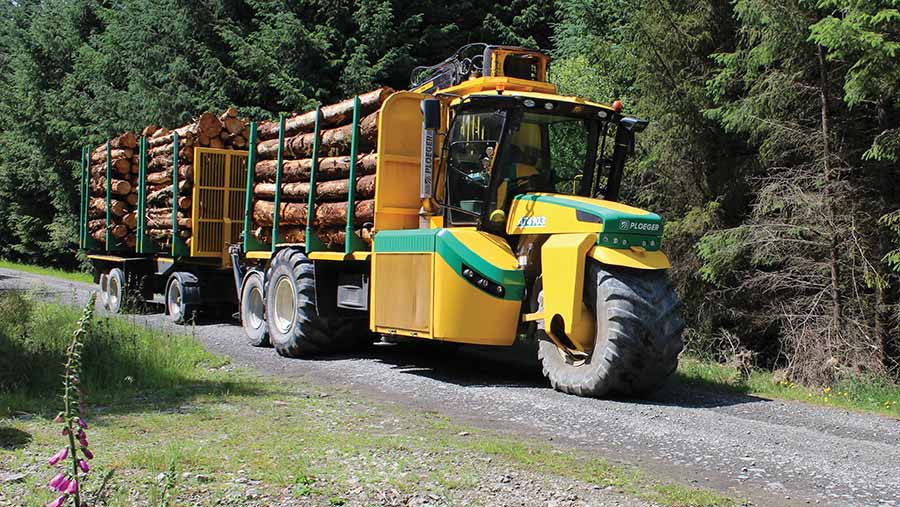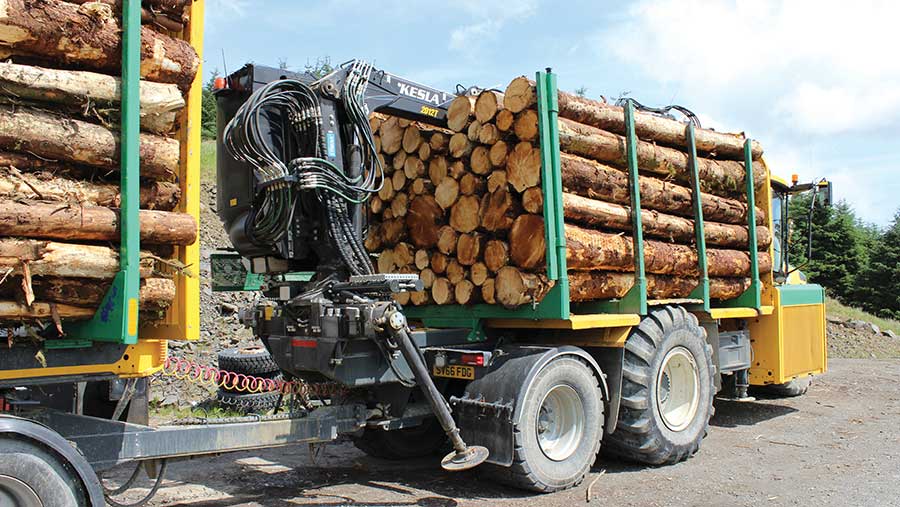Adapted Xerion and three-wheel Ploeger haul timber for Howie
 Adam Howie with the Valtra T234 and Claas Xerion 4000 Saddle Trac © Peter Hill
Adam Howie with the Valtra T234 and Claas Xerion 4000 Saddle Trac © Peter Hill Apart from the occasional buzz of flies, all is still and quiet in the spectacularly picturesque, timber-clad Shinnel Glen in south-west Scotland.
A bright yellow vehicle briefly adds contrasting colour to the otherwise impenetrable sea of Scots pine, as it inches gingerly down the hillside, before disappearing among the trees.
It takes another 10 minutes or more to re-emerge, and as the revs build to power up the track that winds along the nearside of the valley, the vehicle finally turns a corner to reveal itself in full.
See also: Tips to get the perfect solar-powered electric fence setup

Ploeger AT4103 at the end of a long climb out of the valley © Peter Hill
A Ploeger three-wheel “floater”, usually seen spreading fertiliser or slurry on flat arable fields, is not the sort of thing you expect to come across in the middle of a forest.
But this example, operated by Howie Forestry Solutions, has been adapted to load, haul and offload 15t of pulp wood on its extended deck, plus another 25t on the trailer it pulls.
This is just one of five much modified agricultural vehicles run by the business to extract timber and clear fell brash for biomass from deep in forests throughout Scotland and northern England.
There is an older forerunner in the shape of a 2007 Challenger Terra-Gator, and also a 2017 Claas Xerion 4000 Saddle Trac, plus several different trailers for them to tow, a pair of rather more conventional tractor and trailer combinations, a rigid eight-wheeled Mercedes-Benz truck, and a new Renault 8×8 truck.
Flotation and traction
Capacity aside, the key attraction of the Xerion and floaters is the big tyres, as Adam Howie explains. “We specialise in providing landowners, forestry management companies and harvesting contractors with a timber extraction service, using bespoke machinery that brings low ground pressure principles to the forest.
“Normally, you would see articulated timber lorries on this work, often running several miles into and out of forests, and you soon see evidence of how their concentrated wheelings inflict damage on the forest tracks, especially when it’s wet.
“Tenders for harvesting and contracting usually include the proviso that, at the end of the job, tracks must be maintained to their original condition – which can cost as much as £50,000-£100,000 on a big extraction.”
The machines used by the Howies incur a slightly higher extraction charge, but because the weight is spread over a much larger surface area, they hardly cause any damage.
Any potholes that do emerge are filled in as work progresses, so the overall cost is less in the long run than the conventional approach.
“We avoid having road-going lorries operating off-road, which they are not designed to do, and keep our specialist vehicles off the road. With legislation getting tighter all the time, it helps to keep the lorries legal, as they don’t suffer as many cuts in their tyres and can be maintained more easily by keeping to the tarmac.”

Using bespoke machinery with load-spreading multiple tyres preserves the condition of forest roads © Peter Hill
Diversification
Ian started out as a contractor much like any other, offering agricultural field services from the home farm at Tarbolton near Mauchline, Ayrshire.
But when farmers in the area could use grants and subsidies to buy their own higher-capacity machinery, and go contracting themselves in some cases, he changed tack to focus on forestry operations.
“I started with a 180hp Deutz Agrotron 180.7 and a timber trailer and crane, then moved on to a bigger and more powerful Case IH Magnum with a larger trailer for more output,” Ian recalls.
Recognising the potential for low ground pressure kit, the Terra-Gator came next, and the trend of modifying vehicles and trailers to better suit their role was started.
“The Terra-Gator was supplied by AgChem, with the cab moved forward and the rear chassis extended to accommodate the crane and two bunks of timber.
“The original body was built by Jim Watt at Caledonian Forestry, although we’ve adapted it with various modifications over the years,” notes Ian.
“It’s been a brilliant machine, now on more than 23,000 hours, with a nice Cat 13-litre engine, simple and reliable powershift transmission, and air-operated drum brakes – the sort of things that are relatively easy to fix.”
The Terra-Gator carries its 15-16t load on four 900mm-wide tyres at the back, and a single 1,050mm up front.
The newer Ploeger AT4103 remains a three-wheel drive “trike”, running on a trio of similar-size Michelin and Alliance tyres.
But it has been extended in the Howie workshop with a trailing axle running on smaller wheels at the back, to help support the weight of the load and rear-mounted Kesla crane.
A fold-up gangway with handrail is common to all the machines, giving direct access between the vehicle and crane cabs, and mounting the crane at the rear enables it to load and offload both the vehicle and its trailer.
Despite being a four-wheeler, the Xerion Saddle Trac, with its cab positioned high over the engine in forward-control fashion, meets the Howie’s low ground pressure requirements thanks to the offset steering mode.
It has a space frame chassis extension at the back, where the timber crane is mounted, and was originally equipped with a trailing rear axle plus a central pair of castor wheels at the front for added support.
But although they proved successful to a degree, they have been removed for being a bit too troublesome, and the offset steering mode does a good job of spreading the load anyway.

A chassis extension, trailing axle and Kesla crane equips the vehicle for timber work © Peter Hill
More carrying capacity
A more ambitious modification has been made, however, in that the Xerion has been stretched, with an extra 2m of steel worked into the centre of the chassis to gain extra load volume and spread the weight more evenly.
Complete with its trailer, the Xerion can now haul as much as 45t of timber in one go, compared with the 25t average load of a road-going artic or rigid plus trailer.
Remarkably, this project was completed in the operation’s own workshop, with Adam producing the design and a set of accurate drawings on Fusion 360 CAD software for the first time.
The outcome and professional finish should not come as a surprise, given the multitude of modifications made to the Terra-Gator and Ploeger, and the numerous conversions from twin-axle flatbed road trailers to eight-wheel logging trailers that have been carried out without digital assistance.
With about half a dozen main customers on the books, the Howie fleet is dispatched to local harvesting sites for just a few weeks, or further afield for six to 18 months, extracting anywhere from 300t to 100,000t of timber for saw mills, paper mills, biomass and export.
Individual hauls to a roadside transfer location are also highly variable, from just a couple of miles to more than 20.
“Some jobs just require one of our machines, others all five; it depends upon the harvesting rate and volume of timber scheduled for delivery to the end user, and the length of the haul,” says Adam.
“On big jobs such as clearing for a wind farm, which might need 70 lorries to get the job done, we can do it with crew members who are all familiar with the site, and do half the number of trips to get the timber to roadside.”
Howie Forestry Services: The fleet
Challenger Terra-Gator
- Engine 12.5-litre, 430hp Cat C13
- Transmission Caterpillar 16-speed full powershift
- Modifications Cab moved forward, 1m rear chassis extension, trailing rear axle, timber body, and rear-mounted Kesla 2012T cabbed timber crane
- Tyres BKT Agri Max RT600 – single 1050/50 R32 plus four 900/60 R32
Claas Xerion 4000 Saddle Trac
- Engine 11-litre, 460hp MTU Mercedes-Benz
- Transmission Claas CMatic (ZF Eccom 5.0 CVT)
- Modifications 2m mid-chassis extension increasing wheelbase from 3.6m to 5.6m, rear space-frame extension and trailing axle, timber body, and rear-mounted Kesla 2012T cabbed timber crane
- Tyres Michelin Cerexbib – four IF 900/60 R38 CFO
Ploeger AT4103
- Engine 9.3-litre, 400hp Scania
- Transmission ZF Eccom 5.0 CVT
- Modifications 3.8m rear chassis extension, trailing rear truck axle with hydraulic suspension, timber body, and rear-mounted Kesla 2012T cabbed timber crane
- Tyres Michelin Mega X Bib – single 1050/50 R32 plus two Alliance 900/60 R32
New Holland T8.410 Auto Command
- Engine 8.7-litre, 374hp (409hp boosted) FPT
- Transmission CNH CVT
- Modifications Rear-mounted Kesla 2110T, and front grab bar
- Tyres BKT Agrimax Force IF 900/60 R42 rear, 650/60 R34 front
Valtra T234
- Engine 7.4-litre, 235hp (250hp boosted) Agco Power
- Transmission Valtra 30-speed semi-powershift
- Modifications Rear-mounted Kesla 800T, front grab bar
- Tyres Bridgestone VX-Tractor – 650/65 R42 rear, 600/65 R30 front

